In Search of the Niinja (27 page)
Read In Search of the Niinja Online
Authors: Antony Cummins

According to Fujibayashi, daytime infiltration is at times when a shinobi’s movements would be ignored, when the household is waking, at midday and also at mid-evening, all of which revolve around meal times or when people are moving around.
An investigation into night-time operations displays that the times recorded in the manuals shown above do not show an early understanding of the sleep cycle
81
and are not based on when a person is most likely to be in a deep sleep.
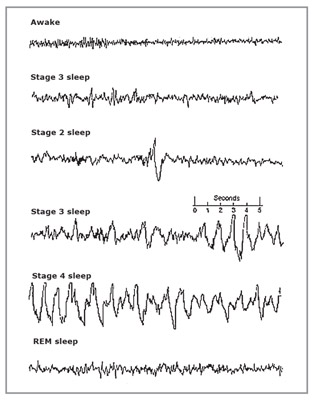
The sleep cycle.
The ninja is not concerned with how the person is sleeping, only concerned with whether or not they are asleep.Natori states that most people fall asleep around 1am and that shinobi should stop infiltrating at this time and start again at 3am. In fact, research shows that the deepest sleep can happen in the first sleep cycle of the night, which according to Natori is exactly when a ninja should not infiltrate. It is advised that a ninja should infiltrate between 9pm and 11pm and the reason for this is explained in the
Bansenshukai
.
Dusk, is the time when movement and preparation in a household take place and when visibility is low, therefore, it is easy for the shinobi to walk among the people, listening to facts and carrying out fake preparation tasks making others believe he is part of the household staff. This time merges into the next positive infiltration time, between 11pm and 1am. Natori states that most people go to bed before 11pm but that they do not sleep before 1am. This would mean that people may still be walking around, making visits to the latrines or generally still in some form of movement, thus any noise or movement the ninja makes would most likely not bring any attention to him. Then at 1am a ninja is told to stop and to not infiltrate as by 1am, because most people are asleep and movement in the house has stopped. In this situation, any unusual movement would bring unwanted attention from the household or any guards. Natori then says that people wake between 5 and 6am, when again movement would occur and this is considered a positive time to infiltrate as people are again involved in preparation activities. In Japan, especially in summer it is relatively bright by this time and that it can no longer really be considered night.
Between the hours of 3am and 5am should be considered positive times to infiltrate, yet the reasons for this statement are unknown. It is possible that the ninja themselves believed that people were in a ‘deeper sleep’ at this point, or alternatively, this time was in fact another period of movement. Perhaps, as discussed in the
Bansenshukai
, this is the period where night-time guards are starting to let their concentration slip, because between the hours of three and five there is the end of the night watch and the rise of the household occupants. This could mean that a ninja waits for this time as the guards are becoming lax, or if the ninja’s movements are heard, a guard may attribute the movement to a member of the house who has woken early, such as kitchen staff and servants.
On the whole, it appears that shinobi would infiltrate when their presence was disguised by other noises or movement from within a household compound. The result of this is that a ninja would concentrate on hiding noise or blending in with the surroundings and acting as a member of a household – hardly the stereotypical image of the figure in black.
82
It must be noted that these times are used to infiltrate a household and not a castle.
The Chinese
Lu-shih Ch’un-ch’iu
states: ‘Ching wanted to launch a surprise attack against Sung so they had scouts first chart the depth of the Young river.’
One fundamental element missing from the modern concept of the ninja is that shinobi were trained in mathematics, geometry and engineering with a focus on understanding enemy fortifications and defences. A shinobi had to have the ability to quickly calculate enemy numbers, dependent on elements such as the length of an army’s marching order and the number of columns; the height of enemy fortifications, so that they could calculate the trajectory needed for a fire rocket assault; and the depth and width of water defences such as rivers and moats. A basic understanding of mathematics was a fundamental part of a ninja’s arsenal.
The following translation comes from the
Chuken Jutsu Hiden
scroll, which is a collection on the art of measurement and contains a section dedicated to ninjutsu.
The Skill of Estimation [of distance] During Night Time:
Use a [distant] fire or a specific point such as a mountain as a guide and ‘target’ for this skill. Stand a stick of incense on a flat plate or a ruler and hold a carpenter’s iron square alongside it. Next, to determine how many Cho in distance it is to the target you should trap a Hinawa burning fuse in the gap of a partially split bamboo and make sure you know the distance between the two people [marked by on the drawing], then look to the target [fire or point] in front of you and use
on the drawing], then look to the target [fire or point] in front of you and use
Kokogen no jutsu
which is Pythagorean theorem. This is
shinobi no jutsu
.
How to Calculate Distance Beyond a Mountain:
83
If there is a mountain in front and it is hard for you to look out across it, pick a point on the mountain top, such as a tree or a rock, as a reference. Next turn to the base of the mountain [where the person in the diagram is] then look out to target [which is beyond the mountain] and use the art of
in the diagram is] then look out to target [which is beyond the mountain] and use the art of
Mikaeshi no jutsu
.
84
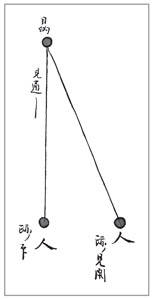
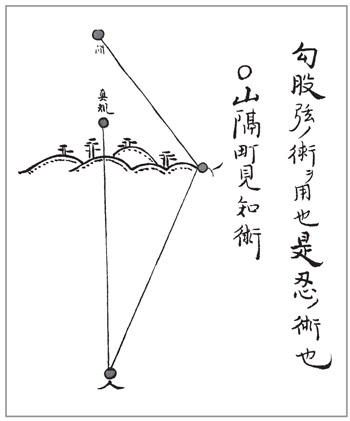
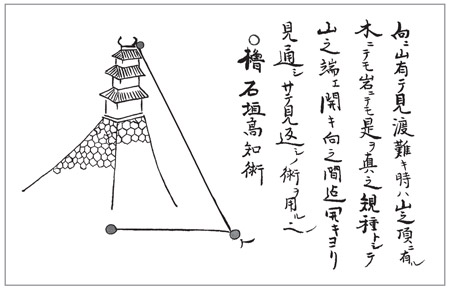
Estimating the Height of a Turret or Stone Wall:
Take the top of the turret or wall as a reference and mark it, then using the bottom [measurement and the angle between the ground and the turret] you can use
Kokogen no jutsu,
which is Pythagorean theorem.
The Shinobi Way of Knowing Distance:
Stand a stick of incense inside this bamboo tube. On a bamboo cylinder of seven or eight Sun in length, make a mark for every five Bu and drill holes through which you can see the incense burning down. Make sure the holes are large enough to see through.
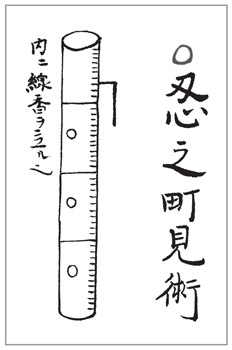
In preparation for this skill, you must record how many of these marks a single incense stick will burn past for the distance of one Cho of average travel. Once you know this number, then walk with this cylinder on your waist and with an incense stick burning in it. This way you can measure the distance that you travel with this skill. Also, for the sea or a river, you can estimate the distance you have travelled with this skill. However, you need to consider the speed of the boat.
Often when people contest the validity of the ninja and the recorded skills that they, the shinobi, attribute to themselves, people point to the ‘Water-Spider’ tool or ‘shoes for floating on water’, attempting to discredit the writings of the shinobi as fantasy. Ironically, this highly publicised mistake was introduced and promoted by the ninja-supportive researcher Fujita Seiko and the mistake has even made it as far as popular television in the programme
Mythbusters
.
People believe that the ‘Water-Spider’ tool is supposed to be a pair of shoes that a ninja would use to ‘float’ across water and get to the other side. In reality it is not a pair of ‘Water-Spiders’ but a single ring used as a flotation device.
